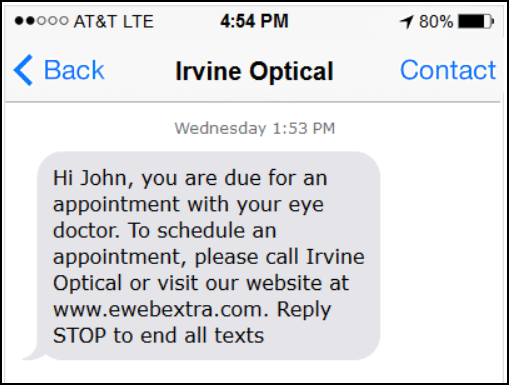 |
|
This analysis found that 22% of no-show patients made it in for an appointment within 30 days after receiving an automated message from the practice’s EHR, twice the rate of those who only received a message by hardcopy mail. Photo: Irvine Optical. Click image to enlarge. |
Electronic health record (EHR)–based reminder messages may help patients re-engage in eye care after a missed appointment, according to findings from a prospective, randomized clinical trial.
This study included patients aged 18 year or older in an academic ophthalmology department who had a “no show,” or missed appointment. Over the course of two recruitment phases, 362 patients who had an active EHR patient portal were selected consecutively each business day.
Researchers randomized patients using a web-based tool to receive a rescheduling reminder via standard mailed letter only or a mailed letter plus an electronic message through the EHR within one business day of the missed appointment. In this analysis, the study authors defined reengagement with eye care as “attendance of a rescheduled appointment within 30 days of the no-show visit.”
Among study participants, the average age was 59.9 years, 42.5% were male, 56.9% were Caucasian and 36.2% were Black. Overall, most patients were recruited from the retina service (39.2%) followed by the glaucoma service (29.3%).
Data showed that many of the individuals included in this study had previous missed appointments. The average no-show rate was 18.8% out of all scheduled visits across the health system. Of the patients who received an electronic message via the EHR, 22% attended a follow-up appointment within 30 days of their no-show visit compared to 11.6% of those who only received a reminder through standard mail.
When looking at only the 74 patients in the intervention cohort who read the electronic message in the patient portal, 28.4% had a follow-up appointment vs. the 11.6% in the control group, according to the researchers.
“A standard EHR-based reminder message sent via a patient portal within one business day after an appointment no-show doubled the likelihood of patient re-engagement with care within 30 days of missed appointment,” the study authors noted in their recent American Journal of Ophthalmology paper.
Atta S, Brown RB, Wasser LM, et al. Effect of a patient portal reminder message after no-show on appointment reattendance in ophthalmology: a randomized clinical trial. American Journal of Ophthalmology. February 23, 2024 [Epub ahead of print]. |

